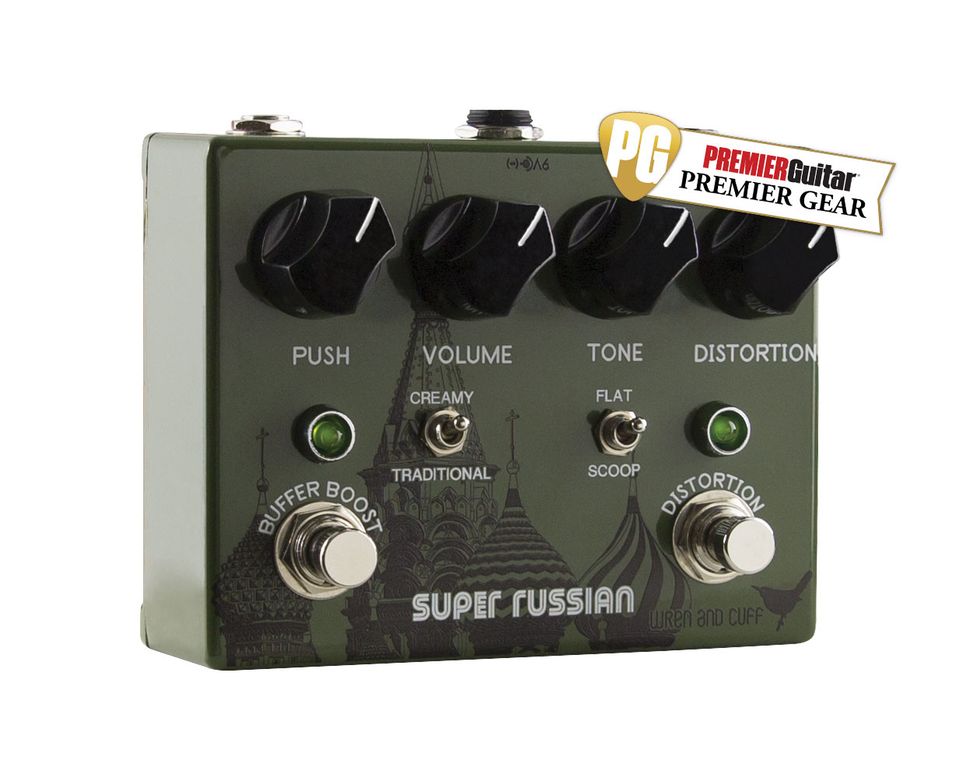RatingsPros:Beautiful variations on Sovtek-style tones. Copious tone-shaping options. Very nice boost circuit. Cons: Mid-forward settings can sound too dense. Street: $225 street Wren and Cuff Super Russian wrenandcuff.com | Tones: Ease of Use: Build/Design: Value: |
With little fanfare, Wren and Cuff has evolved into one of most reliably excellent small pedal makers in the world. The last few years have seen the company diversify beyond their fuzz roots to build an imaginatively executed germanium compressor and chorus/vibrato pedals, among others. But their reputation was built on Big Muff clones. And as the new Super Russian makes plain, the Southern California company’s Muff-style pedals still rank among the best.
The Super Russian marks a departure in some ways. Rather than recreate an existing Muff circuit to some exacting standard, Matthew Holl’s used his version of the classic Tall Font Russian circuit as a jumping off point, leveraging his fluency in Muff circuitry to add new inflections to familiar mods and to the Tall Font circuit itself. It’s among the most flexible Sovtek-inspired pedals I’ve ever played.
Built to Bully
The fit, finish, and design that goes into Wren and Cuff pedals is always apparent. And though the inverted circuit board means you don’t see what components populate it, you do see ample evidence of careful construction. Jacks are chassis-mounted. And while I didn’t confirm it with Holl, I suspect even the selection of the included Sunbeam 9V battery, which reads “Super Heavy Duty” on the side, was carefully considered.
Topside, things are busier than your average Muff. The three rightmost knobs, volume, tone and distortion, are typical Big Muff stuff. The two sturdy mini toggles, however, activate two “mods” that transform the Tall Font circuit. The switch on the right shifts the EQ profile from the classic scooped Sovtek sound to what Wren and Cuff calls a flat EQ setting. The left toggle activates Holl’s version of the famous (if somewhat controversial) “Creamy Dreamer” mod. The left footswitch activates the pedal’s germanium boost circuit—a very nice, transparent boost, controlled by the “push” knob that works seamlessly with the Tall Font Russian circuit.
Blast First
On balance, the Tall Font side is buzzier and airier than my Sovtek or any of my favorite Sovtek clones—a very cool thing. You hear a lot more detail and articulation, and there’s less of the dynamics-blurring compression that can make even the best Muffs sound muddy for certain leads and complex chords.
Flat mode changes the Super Russian’s personality considerably. The additional midrange makes the basic tone much more heavy metal. That will please players that lament the way a Muff can go missing in a loud band. It may be less popular with Sovtek traditionalists that like the gauzy, hazy mystery of the mid-scooped profile. One super-cool possibility opened up by the flat mode is the filter-y, cocked-wah-style lead sounds you can get when you advance the distortion and tone. It’s killer for twisted, monstrous variations on psych-punk biker fuzz tones.
Creamy mode is a nod to the famous/infamous Creamy Dreamer mod that many Smashing Pumpkins fans adopted to replicate Billy Corgan’s Siamese Dream tones. (All for naught, it turns out: Corgan used an OpAmp Big Muff rather than a silicon-transistor variant.) To my ears, the high-gain creamy mode is less flattering to the old-school scooped setting—rendering dynamics and note detail less distinct and robbing the distortion profile of much needed oxygen. Using it with the flat setting helps offset the muddiness with extra high-mid presence, though this setting, too, gives the pedal a brick-walled, everything-in-the-red feel. Whether this is good or bad is very subjective. I thought it sounded awesome for gnarly, mid-focused single-note lead tones, but enjoyed it much less for chords and dense note clusters, where I wanted to hear the growling harmonic rainbow of the Tall Font circuit.
My favorite tones came by way of marrying the very effective germanium boost to the traditional, scooped Tall Font setting. They’re a great match, and the germanium boost lends vibrancy to the Tall Font circuit’s already very pretty distortion colors. The boost circuit also shifts the more aggressive flat and creamy modes from stun to kill. It can be an amazing tool for putting a lead out in front of a band, though it also highlights the creamy mode’s wall-of-sound intensity.
The Verdict
Even if you only use the traditional, scooped Tall Font circuit along with the boost, the Super Russian is a good value for a superb Sovtek-style pedal. And even though I love Sovtek-style scooped tones, I found that the flat and creamy modes could be tailored in cool ways using the very responsive tone control. For players that love mid-forward, wall-of-fuzz variations of the Muff voice, the Super Russian will be a tone bonanza.












![Rig Rundown: Russian Circles’ Mike Sullivan [2025]](https://www.premierguitar.com/media-library/youtube.jpg?id=62303631&width=1245&height=700&quality=70&coordinates=0%2C0%2C0%2C0)








